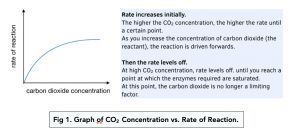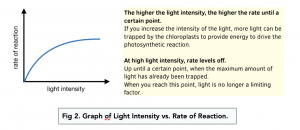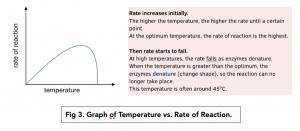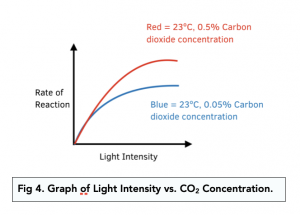Limiting Factors of Photosynthesis (A-level Biology)
Limiting Factors of Photosynthesis
Factors Affecting Photosynthesis
A limiting factor is something which determines the efficiency and rate of the reaction due to their availability. In this case, the rate of photosynthesis determines how much triode phosphate, and eventually glucose and starch, a plant can produce.
The table below lists certain factors photosynthesis requires to occur.

A lack of availability of any of these factors can cause problems for a plant, slowing down the speed of photosynthesis, preventing plants from producing enough food stores. This will lead to a fall in plant growth, eventually dying as it is unable to meet its energetic needs.
Below we will look into some of the above factors which limit photosynthesis in more detail:
1. Carbon Dioxide
This is a key factor affecting photosynthesis.
- Low CO2 affects the Calvin Cycle. If CO2 levels are low, rubisco cannot convert RuBP to GP in step one of the Calvin Cycle. This leads to accumulation of RuBP and an overall slowing of the Calvin Cycle, which results in a fall in the production of TP/GALP.
- High CO2 can cause stomata to close. However, if CO2 rises too high, then some stomata begin to close, which can lead to less CO2 uptake by the plant.
- The ideal CO2 concentration is 0.4%. The atmospheric CO2 concentration is 0.04%. Increasing this by ten times to 0.4% will increase the rate of photosynthesis.

2. Water Supply
This is another important factor affecting photosynthesis
- Water is needed for photolysis in the light-dependent stage. Low levels of water prevent efficient photolysis occurring during the light dependent reactions. This will disrupt production of ATP and reduced NADP, both of which are needed for the Calvin Cycle.
- Water vapour and soil are sources of water. Plants can obtain water through their stomata from water vapour in the air, and also by absorbing water from soil via their roots.
3. Light Intensity
- Light is needed for the light-dependent stage. Light energy is needed to excite the electrons and for photolysis of water in the light-dependent stage. Without light, there would be little ATP and reduced NADP produced for the Calvin Cycle.
- Certain wavelengths of light are absorbed. Light is absorbed by the photosynthetic pigments (e.g. chlorophyll a), as we learnt before. Green light is not absorbed but is instead reflected.

4. Temperature
- Low temperatures reduce the rate of enzyme action. Many of the reactions in both the light dependent and independent reactions are enzyme-driven processes. Enzymes require an optimal temperature to function. In low temperatures, there is not enough kinetic energy in the chloroplast to allow for effective collisions between enzymes and their substrates. This leads to a fall in the rate of photosynthesis and TP production.
- Very high temperatures also reduce the rate of enzyme action. At high temperatures, enzymes can become denatured. Also, stomata tend to close at high temperatures to avoid water loss, which means less CO2 is available for photosynthesis.

Limitating Factors of Photosynthesis: Light Intensity and CO2 Concentration
We can also look at a combination of factors together:

- In the above graph, temperature is constant, so the effect of light intensity and carbon dioxide concentration on photosynthesis is shown.
- As you increase light intensity, rate increases until we reach a plateau, after which light is no longer the limiting factor.
- As you increase CO2 (shift from 0.05% to 0.5%), the rate increases. Also, the light intensity effect plateaus at a higher level, so light intensity is a limiting factor for longer.
Agricultural Factors
Greenhouses can optimise farming conditions. Greenhouses have artificially made conditions in order to farm more efficiently.
Greenhouses control temperature:
-
- Glass – greenhouses are made of glass in order to trap the sun’s heat, via the greenhouse effect, in the summer to increase the speed of photosynthesis.
-
- Blinds – they have blinds that are used if it is too hot to stop the denaturing of enzymes.
-
- Heaters – during the cold months, farmer use heaters inside the greenhouse in order to artificially provide heat to keep plants photosynthesising year round.
- Greenhouses control CO2 concentration. Greenhouses can burn paraffin heaters to give off carbon dioxide for photosynthesis, whilst heating the greenhouse.
- Greenhouses control light intensity. Light can be artificially provided (i.e. lamps) to provide the energy for photosynthesis. Greenhouses tend to have glass to allow maximum sunlight through.
- Conditions must be carefully monitored. This is an intensive process, so it must be done as efficiently as possible to provide the greatest amount of produce for the money put in.
In conclusion, we have looked at photosynthesis and factors affecting photosynthesis in great detail.
FAQs
Photosynthesis is the process by which plants, algae, and some bacteria convert light energy into chemical energy in the form of glucose. This process is essential for the survival of these organisms as well as for the production of oxygen in the atmosphere.
Limiting factors are environmental conditions or factors that restrict the rate of photosynthesis. These factors can include light intensity, carbon dioxide concentration, temperature, and water availability.
Light intensity is one of the most important limiting factors in photosynthesis. When light intensity is low, the rate of photosynthesis decreases. When light intensity is too high, it can cause photoinhibition, which is a decrease in the rate of photosynthesis due to damage to the photosynthetic machinery.
Carbon dioxide is another important limiting factor in photosynthesis. When the concentration of carbon dioxide is low, the rate of photosynthesis decreases. When the concentration is too high, it can lead to photorespiration, which is an increase in the consumption of oxygen and a decrease in the production of glucose.
Temperature also affects the rate of photosynthesis. When temperatures are too high or too low, the rate of photosynthesis decreases. The optimal temperature for photosynthesis varies depending on the type of organism, but it is typically between 20-30°C.
Water is essential for photosynthesis as it provides the hydrogen ions needed for the production of glucose. When water is limiting, the rate of photosynthesis decreases. Additionally, when water is in short supply, plants close their stomata to conserve water, which can also decrease the rate of photosynthesis.
The rate of photosynthesis is affected by the availability of light, carbon dioxide, temperature, and water. When any one of these factors is limiting, it restricts the rate of photosynthesis. In order to maximize the rate of photosynthesis, it is important to provide the optimal levels of all of these factors.
Limiting factors can have a significant impact on the overall productivity of an ecosystem. For example, if light is limiting, the rate of photosynthesis will be restricted, leading to lower productivity. If water is limiting, plants will close their stomata, which can decrease the rate of photosynthesis and lead to lower productivity. It is important to understand the impact of limiting factors in order to manage and sustain the productivity of an ecosystem.






Still got a question? Leave a comment
Leave a comment